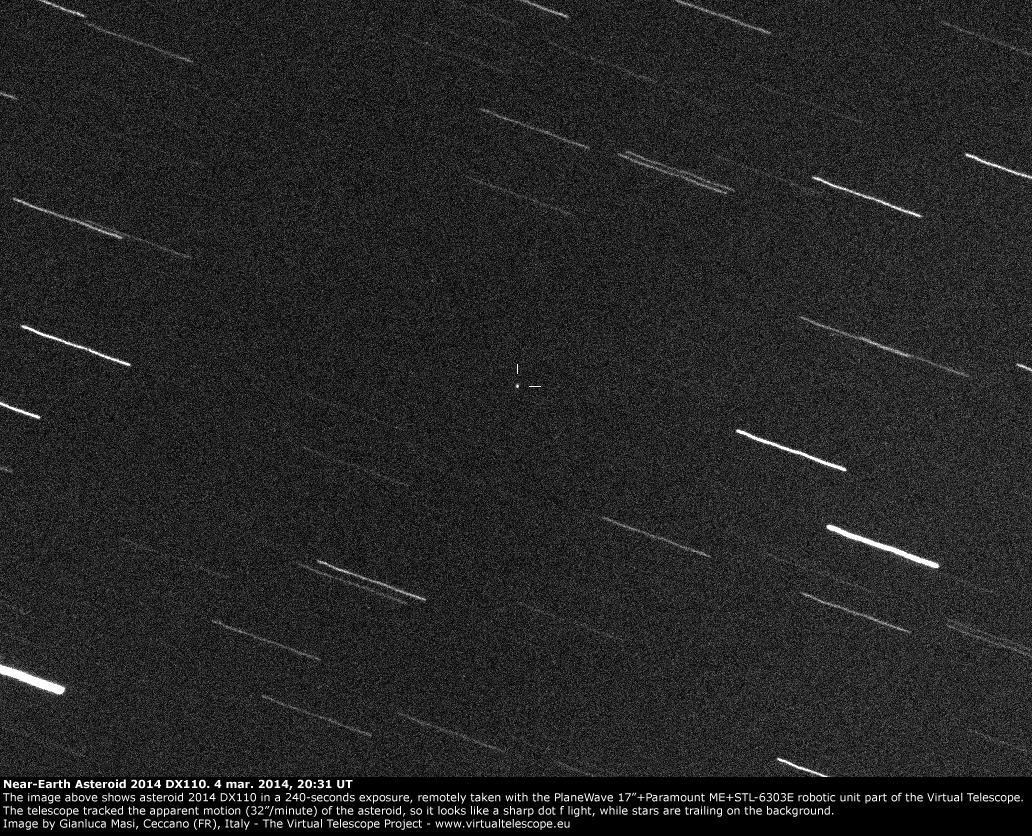100-Foot Asteroid Buzzing Earth Today, Is Closer Than the Moon: Watch It Live
A newfound asteroid will buzz close by Earth today (March 4), flying safely between our planet and the orbit of the moon, and you can follow the space rock encounter live online.
The asteroid 2014 DX110 will zip by Earth at 4 p.m. EST (2100 GMT) today, just days after its discovery on Feb. 28. NASA officials say it poses no threat to the Earth.
"This asteroid, 2014 DX110, is estimated to be about 100 feet (30 meters) across," officials at NASA's Jet Propulsion Laboratory in California wrote in an alert. "Its closest approach to Earth will be at about 217,000 miles (about 350,000 kilometers) from Earth at about 1 p.m. PST (4 p.m. EST) [2100 GMT] on March 5. The average distance between Earth and its moon is about 239,000 miles (385,000 kilometers)." [Photos: Potentially Dangerous Near-Earth Asteroids]
Two web-based skywatching services, the online Slooh observatory and the Virtual Telescope Project in Italy, will attempt to offer free live views of asteroid 2014 DX110 during its flyby. You can watch both asteroid flyby webcasts on Space.com here, beginning at 3:30 p.m. EST. The webcasts are heavily dependent on weather conditions at the observing sites.
The first asteroid 2014 DX110 webcast at 3:30 p.m. EST comes courtesy of the Virtual Telescope Project overseen by astrophysicist Gianluca Masi in Ceccano, Italy. The webcast will cover the incoming asteroid's approach and closest flyby to Earth during today's space rock encounter.
Masi observed the asteroid Tuesday night by telescope, snapping a photo that revealed the asteroid to be a white pinprick of light in a sea of black space. You can follow Masi's webcast directly at the Virtual Telescope Project website here.
At 4 p.m. EST (2100 GMT), the Slooh observatory will webcast its own coverage of asteroid 2014 DX110 using the company's remote-controlled telescopes. Slooh's Paul Cox will host the observing event.
Get the world’s most fascinating discoveries delivered straight to your inbox.
Slooh officials said it will be a challenge to see asteroid 2014 DX110 because, "with its small size, location, and incredible rate of motion, there is a high probability we will not capture the asteroid during the broadcast."
Today's webcast is one of two asteroid live events in a single week by Slooh. The online skywatching project will host a second webcast on Sunday night (March 9) to track the newfound asteroid 2014 CU13.
Asteroid 2014 DX110 was discovered last week by astronomers using the space rock-hunting Pan-STARRS 1 telescope in Haleakala, Hawaii. The telescope is one of many around the world used to seek out and track near-Earth objects. NASA's Near-Earth Objects program at the Jet Propulsion Laboratory in Pasadena, Calif., oversees one of those efforts.
"NASA detects, tracks and characterizes asteroids and comets using both ground- and space-based telescopes," JPL officials said in a statement. "The Near-Earth Object Observations Program, commonly called 'Spaceguard,' discovers these objects, characterizes a subset of them and identifies their close approaches to determine if any could be potentially hazardous to our planet."
Email Tariq Malik at tmalik@space.com or follow him @tariqjmalik and Google+. Follow us @Spacedotcom, Facebook and Google+. Original article on Space.com.

Tariq is the editor-in-chief of Live Science's sister site Space.com. He joined the team in 2001 as a staff writer, and later editor, focusing on human spaceflight, exploration and space science. Before joining Space.com, Tariq was a staff reporter for The Los Angeles Times, covering education and city beats in La Habra, Fullerton and Huntington Beach. He is also an Eagle Scout (yes, he has the Space Exploration merit badge) and went to Space Camp four times. He has journalism degrees from the University of Southern California and New York University.



